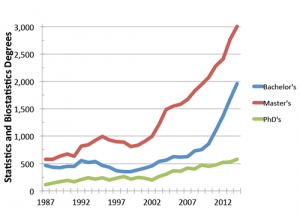TAS Special Issue: Undergraduate Curriculum
Nicole Lazar
The November 2015 issue of The American Statistician is a special issue on statistics and the undergraduate curriculum. You will read about innovations in statistics education beyond the first introductory course. The authors of these papers tackle a wide range of questions that are central to the way in which we think about our undergraduate programs. What should the second course look like? How should we train our majors? Can we expose undergraduate students to more advanced concepts? To larger data sets? And how can we tell if any of this is working?
Several broad themes addressed in the 2014 ASA Curriculum Guidelines for Undergraduate Programs in Statistical Science are included in this special issue. An overview of “where we are” by George Cobb is sure to generate discussion. Indeed, you can find an online discussion of his paper, featuring comments from 19 leading thinkers and educators (along with his rejoinder), as a supplement to the print edition. Other papers focus on computation, visualization, simulation, data science, theoretical statistics, and program assessment.
Now is a time of great and rapid change for our discipline in general, and the effects are being felt at the undergraduate level, as well. Data science, Big Data, and the surrounding hype have all led to increased demand on our courses and programs.

Statistics and biostatistics degrees at the bachelor’s, master’s, and doctoral levels in the United States. Data source: NCES IPEDS.
The undergraduate major continues to grow, both in the number of programs offering the bachelor’s degree and in the number of degrees awarded, which quadrupled between 1987 and 2012. We are thus at an appropriate juncture to step back, take stock of what we are doing, and think about what we could be doing differently or better.
Guest editors Jo Hardin and Nicholas Horton have put together a stimulating set of articles from some of the leading researchers in statistics education, who provide thoughtful answers to many of the questions I’ve raised here. I hope you will find ideas in this issue to improve and reinvigorate your programs and inspire your teaching.

















